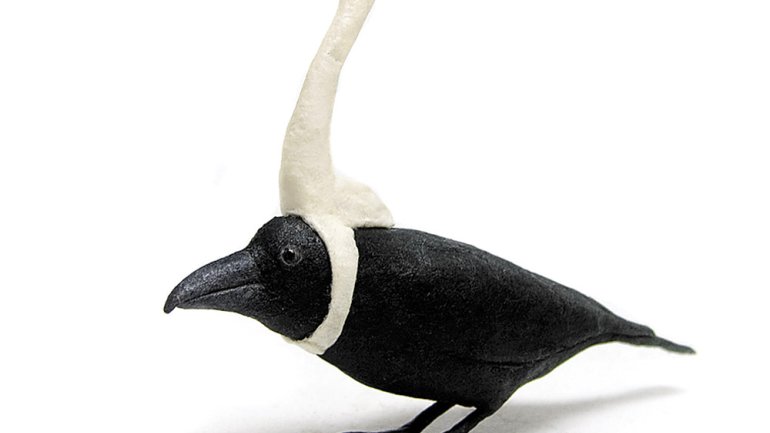Paper Narratives
Paper Narratives
While Kyoko Okubo works in a medium that represents Japanese traditions, her sculptures provide a visual landscape
entirely her own—a place of animals, gentle young girls and nuanced relationships.
Kyoko Okubo calls herself a doll maker. Yet, upon closer inspection, one sees that this extremely private Japanese artist is much more than that. Her tiny sculptures are meticulously crafted from washi, the traditional paper of Japan. This crisp, sturdy material, which is created from fibers from the bark of the gampi tree, the mitsumata shrub or the paper mulberry, is much more than useful object. Washi—which means “Japanese paper”—represents traditions handed down from generation to generation. And while today the material is often mass-produced, it is still handmade in rural communities throughout the country.
Okubo began playing with washi as a child. It was a hobby, not a career. Then 12 years ago Okubo, now in her mid-30s and living in Tokyo, began making dolls. Her pieces, usually women or lifelike animals, are no more than 12 inches high. She presents what is familiar, only to surprise the viewer with an inexplicable element in the work. A kangaroo stands quietly while being lassoed by a young woman. A black crow wears a headdress in the shape of a swan’s head. Okubo’s sculptures are aligned with the maternal. Her most powerful works suggest a bond between a girl and an animal—expressing a moment of attachment captured as if by a camera lens.
Initially crafting her sculptures as private explorations, Okubo intended these curious figures for an audience of one—herself. Her motivation was to represent through physical objects her most personal feelings. Later, she began to show these efforts to family and close friends, and eventually shared this vision with others. Yet the art world in Japan is a rigid and formal one, with few possibilities for a self-trained artist. Faced with limited options, Okubo took her work to Tokyo’s Harajuku district. On a piece of fabric on a sidewalk, she had her first one-woman exhibition. She immediately had a following.
That following now reaches far beyond Harajuku. In addition to a two-person show at Mobilia Gallery in Cambridge, Massachusetts, in 2007, she has participated in the gallery’s theme exhibitions, crafting a conceptual teapot made of paper for “The Teapot Redefined” and a paper goblet for “The Goblet Redefined” shows. The Museum of Arts and Design acquired the latter for its permanent collection. Mobilia’s support of Okubo’s career continues; they showed her work at SOFA New York this year.
No one is more surprised about her transition from the streets into galleries and museums than Okubo herself. Expressing her intimate emotions was a huge risk, and she is moved that so many have embraced her. This reaction may be even more shocking given Japan’s past. Historically, the feminine voice has not been present in Japanese fine art. Even today, many Japanese women sculpt and paint in the aggressive, masculine manner of their male colleagues. Artists such as Takashi Murakami and Yoshitomo Nara have influenced a generation of young Japanese artists in style and content. Intentionally childlike, manga-inspired or playfully combative, this art represents a particular point of view. Yet the range of such work is limited and there is more to the Japanese experience.
Okubo was not afraid to reach beyond this, possibly because she did not start out creating work for others to view. While at first glance her work may seem similarly childlike, it was not done from a child’s point of view. Her sculptures provide a visual landscape entirely her own—a place of animals, young girls and nuanced relationships. Responding to her emotions, Kyoko Okubo has shaped a collection that is profoundly personal and visually compelling.

